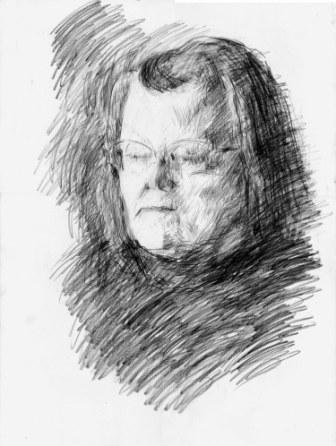Shortly after Bill died, I wrote in my column about my experiment with a meditation on music. “Next Wednesday, July 7, Gustav Mahler and I will celebrate our birthdays, his 150th, my 76th. To commemorate the occasion I’m listening to all ten of his symphonies. I sit in the cozy corner of my lovely study, looking out on trees and birds through the large windows, my Crimmins coffee mug at hand, and begin the morning with music. On the table beside me are two articles about the symphonies, with photos of Mahler--who looks very like my father-in-law and a little like Bill.
I dislike music as background. It disturbs me at parties, in restaurants—makes my poor brain go all jittery. This opportunity to be alone and concentrate completely on the symphonies is unprecedented in my life.
Listening to classical music makes time slow down. I’m surprised when I see that the second movement of Symphony One took only nine minutes--it contained so much. While I was sitting in the hospital with Bill, time also moved slowly. It didn’t “drag”; it just slowed down. When you watch a movie or read a page-turner novel, time flies by. The iTunes software suggested two seconds between movements, but that was not long enough, so after I had downloaded two symphonies, I upped the seconds to five, surprised that I could hear the difference of three seconds.
Several commentators write that each of the ten symphonies is a chapter in Mahler’s whole “novel”, a contemplation of nature, life, death and resurrection. Mariss Jansons writes that each is a stage in a “big journey.” One of the articles is titled “A Mahlerian Odyssey.”
I read that there is a “twittering of birds” in Symphony One. When I heard birdsong, I thought, Oh there it is. But then I realized it was a white-throated sparrow singing in the dying poplar.
A German chorus entered near the end of number two, the “Resurrection Symphony.” I was completely absorbed. The words that came into my head were “Forgive me, forgive me.” I then said the words out loud to Bill. I wept: an authentic catharsis. I did know what they were singing at the very end because a commentator translated it: “Rise again.”
The third symphony is the longest one ever created. Mahler wrote, “…a symphony must be like the world—it must embrace everything.” He did indeed cram: funeral marches, sprightly walking, a posthorn solo, a night bird cry, folksong-like choruses, mournful mezzo soprano solos. He composed it while imagining himself in his coffin. The last movement is tender, excruciatingly painful and sorrowful. I read that this movement would change at the end from the lugubrious D Minor to the more hopeful D Major. Even I could tell when the change occurred. The symphony does end triumphantly with trumpets and incredible tympani wallops.
Mahler regarded the fourth symphony as the closing work of a quartet. It’s a much quieter piece, only four movements, a smaller orchestra. The second movement is about death. David Zinman writes, “…Death fiddling very wildly on an out-of-tune violin.” How does a violinist tune his instrument so it’s correctly out-of-tune? The third movement is breathtakingly lovely. Mahler wrote in the score, “Heaven Opens.”
On the hot evening of July 7th, I sat on the front porch, catching a breeze. The roar of motorcycles off in the distance would occasionally break into my consciousness but that seemed fitting for such bleak music. The whole tenth symphony feels like a cry from the heart, nothing comforting about it, no hopeful resolution. Daniel Harding wrote that a “famous dissonant orchestral scream” punctuates the first movement and that the scherzo is “full of screaming and real angst.” The third movement is titled, “Purgatorio.” The finale has “desolate, isolated music--a last person alive on the earth kind of feeling.” At the end of the manuscript; Mahler wrote, “leb wol/ leb wol/ leb wol”—farewell. When I turned off my CD player, up flashed “Goodbye”; kind of spooky, a heck of a way to start my new year and my new life.

No comments:
Post a Comment